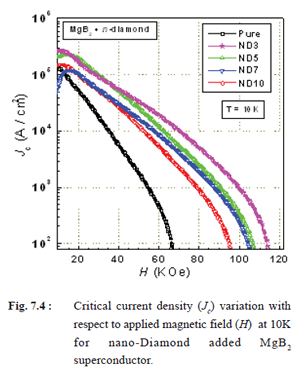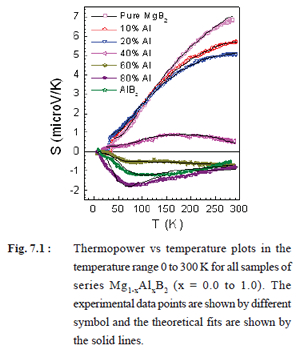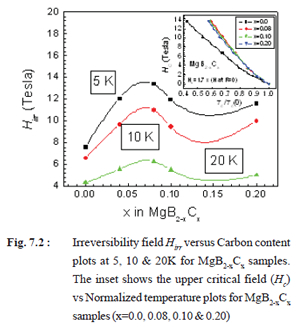A major activity of the division has been continuation of basic research in doped MgB2 superconductors. Bulk samples of MgB2 with different dopants like Al, nano-C, nano-SiC and nano-diamonds were synthesized and characterized by thermoelectric power S(T), magneto-resistivity [r(T,H)] and magnetization M(H) in high fields. A unique phenomenological interpolation formula was evolved to fit both positive and negative S(T) dependence observed as a function of Al concentration in Mg1-xAlxB2. The doping of nano-C, nano-SiC and nano-diamonds were shown to significantly enhance the upper critical field Hc(T), the irreversibility field Hirr(T) and the critical current density Jc(B,T) in the MgB2 bulk material.
Search This Blog
Friday, April 1, 2011
Wednesday, March 30, 2011
Turn Vibrations In To Electricity
With the current talk about global warming, and the impact of carbon emissions on our planet, focus is now shifting to green energy, and wind electricity has reigned supreme in this regard. People, organizations, and even governments are investing heavily in coming up with wind turbines to generate the much needed electricity. However, traditionally wind energy has been associated with huge installation costs, expensive turbines, and so forth. In this regard, researchers have come up with the less expensive Vibro wind set up, which uses less space, is not as expensive, and produces much electricity.
These Vibro wind panels will work like the solar panels do, where they will be fitted on top of buildings, where they will not only generate electricity, but will also convert even minor wind breezes. Unlike windmills and turbines that need plenty of space for them to be installed, the Vibro wind panels will herald a new dawn, where smaller and equally effective wind set ups will be used. It is worth noting that this project is being done in conjunction with engineers and architects, to ensure that it does not flop. This is also meant to ensure that the mechanical energy is easily converted to electrical energy. Conversion of the mechanical energy to electrical energy is being made possible by using a piezoelectric transducer.
Human And Machines Got Even Closer
In this era when technology continues to get advanced and better, it may pleasantly surprise many to note that machines are getting closer to humans and they are performing duties that no one hitherto would be possible. In other words, machines and gadgets are being invented that can imitate the human functioning, for example in the human brain, eyes and so forth.
But perhaps one of the latest inventions, that is a clear manifestation of humans getting even closer to humans, is a machine that has been made and which can imitate the human voice. The machine was invented as part of a completion, for the Artificial Conversational Entities, known as the ACE. Several machines that could imitate the human voice were entered for the competition and the winner was really awesome. During the competition, judges selected some of the five best machines and competed for five minutes, to get the best. This comprised if a five minute kind of interrogation, where there were unrestricted conversations with the machines, which tried to pass of as human beings. So real did these machines sound, that one would not tell whether one was a machine, or a human being.
Brain Scan And Mind Reading – Not So Far
Brain scan and mind reading of the part of the brain responsible for memory have been used to detect a person’s location in the virtual environment. This enables the location of individuals as they navigate through the virtual rooms. These are used to discern what someone was doing, where they are or were and where they are planning to go. This shows that detailed mind reading will be possible with the advancing technology and research.
The hippocampus underpins the ability of a person’s mind to navigate, form, recollect memories and imagine future experiences. The mind reading and scanning is done by using multivariate pattern classification and high resolution functional MRI to decode activities across the population of neurons in the human medial temporal lobe while the participants navigate in a virtual reality environment. The position of an individual can be predicted accurately even when the visual input and task are held constant. Reading precise locations or other types of memory is difficult because fMRI (functional magnetic resonance imaging) resolves the activity of thousands of neurons at a time.
Artificial Cornea Implants – donors of the future
The cornea is the clear protective layer covering the eye. Injuries and diseases affecting the cornea might lead to adverse eye problems like blurred visions. The cornea is responsible for filtering out ultraviolet rays that comes from the sun. However, with the advancement in medical technologies and the constant efforts of scientists through research, corneal diseases can be treated. The artificial corneal implants are the most recent of the treatments.
Artificial corneal implants proved to be beneficial because: it caters for the huge number of people who are waiting for corneal transplants and operations for instance Europe has a waiting list of over 40000 people and a worldwide list of 10 million. They are also biocompatible ensuring that there are no complications when in contact with the eye surface. In cases where traditional corneal transplants (also referred as corneal grafts) have failed to work, artificial cornea can be used. The risk of getting diseases from donors is also reduced. It prevents astigmatism and enhances rapid visual recovery. Additionally, they are useful to patients who have not qualified to get living cornea donors.
3D printing
3D Printing Technologies
3D printing is used to come up with three dimensional objects and is a form of additive manufacturing. It is now easier and more affordable to come up with a prototype using the 3D technology. Before these technologies were introduced, it used to take several hours, skilled labor and tools to create a prototype.
One form of 3D printing technology is made up of inkjet printing systems. Fine powder layers made of resins, corn starch or plaster is bonded selectively on adhesives produced by the inkjet print heads. This kind of technology makes it possible to print a full color prototype and is considered to be one of the fastest methods.
Sunday, March 27, 2011
Messenger
MESSENGER Begins Historic Orbit Around Mercury
 NASA’s MESSENGER spacecraft successfully achieved orbit around Mercury at approximately 9 p.m. EDT Thursday. This marks the first time a spacecraft has accomplished this engineering and scientific milestone at our solar system's innermost planet.
For the next several weeks, APL engineers will be focused on ensuring the spacecraft’s systems are all working well in Mercury’s harsh thermal environment. Starting on March 23, the instruments will be turned on and checked out, and on April 4 the mission's primary science phase will begin.
NASA’s MESSENGER spacecraft successfully achieved orbit around Mercury at approximately 9 p.m. EDT Thursday. This marks the first time a spacecraft has accomplished this engineering and scientific milestone at our solar system's innermost planet.
For the next several weeks, APL engineers will be focused on ensuring the spacecraft’s systems are all working well in Mercury’s harsh thermal environment. Starting on March 23, the instruments will be turned on and checked out, and on April 4 the mission's primary science phase will begin.
 NASA’s MESSENGER spacecraft successfully achieved orbit around Mercury at approximately 9 p.m. EDT Thursday. This marks the first time a spacecraft has accomplished this engineering and scientific milestone at our solar system's innermost planet.
For the next several weeks, APL engineers will be focused on ensuring the spacecraft’s systems are all working well in Mercury’s harsh thermal environment. Starting on March 23, the instruments will be turned on and checked out, and on April 4 the mission's primary science phase will begin.
NASA’s MESSENGER spacecraft successfully achieved orbit around Mercury at approximately 9 p.m. EDT Thursday. This marks the first time a spacecraft has accomplished this engineering and scientific milestone at our solar system's innermost planet.
For the next several weeks, APL engineers will be focused on ensuring the spacecraft’s systems are all working well in Mercury’s harsh thermal environment. Starting on March 23, the instruments will be turned on and checked out, and on April 4 the mission's primary science phase will begin.Nasa
NASA Has a Crush on You

Click to enlarge

Click to enlarge
A massive 27.5-foot-diameter (8.4m) and 20-foot-tall (6.1m) fully-instrumented test article was moved into location in Marshall's Engineering Test Laboratory in preparation for the Shell Buckling Knockdown Factor test. The polka dot pattern applied to the barrel allows the engineering team to capture precise measurements of the deformations of the test article during the test using a technique called photogrammetry, the practice of determining the geometric shape of an object from images. Credit: NASA/MSFC
Watch live TV coverage on NASA Television's Education Channel and the agency's website as NASA engineers test an immense aluminum-lithium rocket fuel tank on Wednesday, March 23, 10:30 a.m. EDT from NASA's Marshall Space Flight Center in Huntsville, Ala.The hope is to use data from the test to generate new "shell-buckling design factors" that will enable lightweight, safe and sturdy "skins" for future launch vehicles. The test is led by the NASA Engineering and Safety Center, or NESC, based at NASA's Langley Research Center in Hampton, Va.
NASA 360's Jennifer Pulley will host approximately two-hours of TV coverage from the test site and interview NESC, Langley and Marshall engineers.
The aerospace industry's shell buckling knockdown factors are a complex set of engineering data that dates back to Apollo-era studies of rocket structures -- well before modern composite materials, manufacturing processes and advanced computer modeling. The hope is for the new test data to update essential calculations that are typically a significant cost, performance, and safety driver in designing large structures like the main fuel tank of a future heavy-lift launch vehicle.
The large-scale test follows a series of smaller scale tests, all aimed at reducing the time and money spent designing and testing future rockets. And by incorporating more modern, lighter high-tech materials into the design and manufacturing process, rockets will save weight and carry more payload.
The 27.5-foot-diameter (8.4m) and 20-foot-tall (6.1m) space shuttle external tank barrel-shaped test article is in place at Marshall's Engineering Test Laboratory. During the test, the section will be sandwiched between two massive loading rings that will press down with almost one-million pounds (453,592 kg) of force on the central cylindrical test article forcing it to buckle.
Leading up to Wednesday's big crush, the shell buckling team has previously tested four, 8-foot-diameter (2.4m) aluminum-lithium cylinders to failure. In preparation for the upcoming test, hundreds of sensors have been placed on the barrel section to measure strain, local deformations and displacement. In addition, advanced optical measurement techniques will be used to monitor tiny deformations over the entire outer surface of the test article. Research to date suggests a potential weight savings of as much as 20 percent.
The principal investigator of the Shell Buckling Knockdown Factor Project is Mark Hilburger, senior research engineer at NASA Langley; Mike Roberts, an engineer in Marshall's Structural Strength Test Branch is the Marshall lead for the test.
The Shell Buckling Knockdown Factor Project is led and funded by the NESC; Marshall is responsible for the test including the engineering, the equipment design, the hardware facilities and safety assurance. Lockheed Martin Space Systems Company fabricated the test article at Marshall's Advance Weld Process Development Facility using state of the art welding and inspection techniques.
Chicken Fat Biofuel: Eco-friendly Jet Fuel Alternative?
In an RV nicknamed after an urban assault vehicle, scientists from NASA's Langley Research Center traveled cross-country this month for an experiment with eco-friendly jet fuel.

Researchers are testing the biofuel on a NASA DC-8 to measure its performance and emissions as part of the Alternative Aviation Fuel Experiment II, or AAFEX II. The fuel is called Hydrotreated Renewable Jet Fuel.
"It's made out of chicken fat, actually," said Langley's Bruce Anderson, AAFEX II project scientist. "The Air Force bought many thousands of gallons of this to burn in some of their jets and provided about 8,000 gallons (30,283 liters) to NASA for this experiment."
Anderson and his team will test a 50-50 mix of biofuel and regular jet fuel, biofuel only, and jet fuel only. The jet fuel is Jet Propellant 8, or JP-8, a kerosene-like mix of hydrocarbons.
Two of the team members headed west in a specially equipped 32-foot (9.75 m) van on loan from Langley's Aviation Safety Program. It's dubbed "EM-50" by researchers after the urban assault vehicle used in the 1981 comedy "Stripes" with Bill Murray.
In an RV nicknamed after an urban assault vehicle, scientists from NASA's Langley Research Center traveled cross-country this month for an experiment with eco-friendly jet fuel.

Click to enlarge
NASA's DC-8 at Dryden Flight Research Center's Aircraft Operations Facility in Palmdale, Calif. Credit: NASA Dryden/Tom Tschida
The Langley team drove 2,600 miles (4,184 km) from Hampton, Va., to meet up with other researchers at NASA's Dryden Flight Research Center in California.Researchers are testing the biofuel on a NASA DC-8 to measure its performance and emissions as part of the Alternative Aviation Fuel Experiment II, or AAFEX II. The fuel is called Hydrotreated Renewable Jet Fuel.
"It's made out of chicken fat, actually," said Langley's Bruce Anderson, AAFEX II project scientist. "The Air Force bought many thousands of gallons of this to burn in some of their jets and provided about 8,000 gallons (30,283 liters) to NASA for this experiment."
Anderson and his team will test a 50-50 mix of biofuel and regular jet fuel, biofuel only, and jet fuel only. The jet fuel is Jet Propellant 8, or JP-8, a kerosene-like mix of hydrocarbons.
Two of the team members headed west in a specially equipped 32-foot (9.75 m) van on loan from Langley's Aviation Safety Program. It's dubbed "EM-50" by researchers after the urban assault vehicle used in the 1981 comedy "Stripes" with Bill Murray.
Saturday, March 19, 2011
INVENTOR OF WWW
Tim Berners Lee has invented something which affects us all on a daily basis, and something which we take for granted, despite being a relatively new concept. Tim Berners Lee invented the World Wide Web. Born on June 8th, 1955 in London, England, Tim was the child of two computer-mad parents, who both met whilst working on a computer to be commercially sold for the first time.
Wednesday, February 16, 2011
AN ATOM
The atom is a basic unit of matter that consists of a dense, central nucleus surrounded by a cloud of negatively charged electrons. The atomic nucleus contains a mix of positively charged protons and electrically neutral neutrons (except in the case of hydrogen-1, which is the only stable nuclide with no neutrons). The electrons of an atom are bound to the nucleus by the electromagnetic force. Likewise, a group of atoms can remain bound to each other, forming a molecule. An atom containing an equal number of protons and electrons is electrically neutral, otherwise it has a positive charge (electron deficiency) or negative charge (electron excess) and is an ion. An atom is classified according to the number of protons and neutrons in its nucleus: the number of protons determines the chemical element, and the number of neutrons determines the isotope of the element
Monday, February 14, 2011
MARSHAL PACKERS AND MOVERS
INTRODUCTION
The most cumbersome task is to pack and move to a new place, be it your residence or workplace. But with Marshal Packers and Movers, you don't need to worry a single bit.We are proud to introduce ourselves as one of the reputed firms in the movement of household and commercial goods.Our Head Office is at Mumbai and the branches are at Ahmadabad, Baroda, Bangalore, Bhopal, Chennai, Chandigarh, Coimbatore, Cochin, Delhi, Dehradoon, Hyderabad, Jaipur Kolkata, Kanpur, Nagpur, Pune, Surat and Vapi. We offer a highly personalized service, which several firms find difficult to compete with. We understand that your possessions are your assets. Hence, it is obvious that transferring your goods from one place to another can cause considerable tension in your mind. We provide our services in household relocation and also in corporate transfers. All the elements of services rendered are discussed in detail with our clients during our preliminary meeting, ensuring a trouble free and comfortable relocation.
For Marshal Packers and Movers, each client is precious with whom it would like to have the best experience.
For Marshal Packers and Movers, each client is precious with whom it would like to have the best experience.
LASER
Laser
| I | INTRODUCTION |
BLACK HOLE
A Black Hole is an extremely dense celestial body that has been theorized to exist in the universe. The gravitational field of a black hole is so strong that, if the body is large enough, nothing, including electromagnetic radiation, can escape from its vicinity. The body is surrounded by a spherical boundary, called a horizon, through which light can enter but not escape; it therefore appears totally black.
NEWTON'S RING
A curved piece of glass resting on a flat piece of glass creates colorful concentric bands, called Newton’s Rings. The rings are caused by light waves reflecting from the two surfaces and interfering, or combining, with each other. A band of color appears wherever the distance between the two pieces of glass causes light of that color to interfere constructively, making the waves bouncing off the two surfaces reinforce each other. At these places, light waves of other colors interfere destructively and tend to cancel each other out.
Sunday, February 13, 2011
LOVE
Love is the emotion of strong affection and personal attachment.[1] In philosophical context, love is a virtue representing all of human kindness, compassion, and affection. In some religious contexts, love is not just a virtue, but the basis for all being, as in the Roman Catholic phrase, "God is love"[2]. Love may also be described as actions towards others (or oneself) based on compassion.[3] Or as actions towards others based on affection
scientist
A scientist in a broad sense is one engaging in a systematic activity to acquire knowledge. In a more restricted sense, a scientist is an individual who uses the scientific method.[1] The person may be an expert in one or more areas of science.[2] This article focuses on the more restricted use of the word. Scientists perform research toward a more comprehensive understanding of nature, including physical, mathematical and social realms.
science
Science (from the Latin scientia, meaning "knowledge") is an enterprise that builds and organizes knowledge in the form of testable explanations and predictions about the world.[1][2][3][4] An older meaning still in use today is that of Aristotle, for whom scientific knowledge was a body of reliable knowledge that can be logically and rationally explained (see "History and etymology" section below).[5]
Since classical antiquity science as a type of knowledge was closely linked to philosophy. In early modern times the two words, "science" and "philosophy", were sometimes used interchangeably in the English language. By the 17th century, "natural philosophy" (which is today called "natural science") could be considered separately from "philosophy" in general.[6] However, "science" continued to be used in a broad sense denoting reliable knowledge about a topic, in the same way it is still used in modern terms such as library science or political science.
Science is "[i]n modern use, often treated as synonymous with ‘natural and physical science’, and thus restricted to those branches of study that relate to the phenomena of the material universe and their laws, sometimes with implied exclusion of pure mathematics. This is now the dominant sense in ordinary use."[7] This narrower sense of "science" developed as a part of science became a distinct enterprise of defining "laws of nature", based on early examples such as Kepler's laws, Galileo's laws, and Newton's laws of motion. In this period it became more common to refer to natural philosophy as "natural science". Over the course of the 19th century, the word "science" became increasingly associated with the disciplined study of the natural world including physics, chemistry, geology and biology. This sometimes left the study of human thought and society in a linguistic limbo, which was resolved by classifying these areas of academic study as social science. Similarly, several other major areas of disciplined study and knowledge exist today under the general rubric of "science", such as formal science and applied science.[8]


A robot is a virtual or mechanical artificial agent. In practice, it is usually an electro-mechanical machine which is guided by computer or electronic programming, and is thus able to do tasks on its own. Another common characteristic is that by its appearance or movements, a robot often conveys a sense that it has intent or agency of its own.
Subscribe to:
Comments (Atom)
 Polycrystalline MgB2-nDx (x= 0 to 0.1) samples are synthesized by solid-state route with ingredients of Mg, B and n-Diamond. The results from magneto-transport and magnetization of nanodiamond doped MgB2-nDx are reported. Superconducting transition temperature is not affected significantly by x up to x = 0.05 and latter decreases slightly for higher x > 0.05.
Polycrystalline MgB2-nDx (x= 0 to 0.1) samples are synthesized by solid-state route with ingredients of Mg, B and n-Diamond. The results from magneto-transport and magnetization of nanodiamond doped MgB2-nDx are reported. Superconducting transition temperature is not affected significantly by x up to x = 0.05 and latter decreases slightly for higher x > 0.05. Thermoelectric power, S(T) of the Mg1- xAlxB2 system has been measured for x = 0.0, 0.1, 0.2, 0.4, 0.6, 0.8 and 1.0. XRD, resistivity and magnetization measurements are also presented. It has been found that the thermoelectric power is positive for x ≤ 0.4 and is negative for x ≥ 0.6 over the entire temperature range studied up to 300 K, see Fig.7.1. The thermoelectric power of x ≤ 0.4 samples vanishes discontinuously below a certain temperature, implying existence of superconductivity.
Thermoelectric power, S(T) of the Mg1- xAlxB2 system has been measured for x = 0.0, 0.1, 0.2, 0.4, 0.6, 0.8 and 1.0. XRD, resistivity and magnetization measurements are also presented. It has been found that the thermoelectric power is positive for x ≤ 0.4 and is negative for x ≥ 0.6 over the entire temperature range studied up to 300 K, see Fig.7.1. The thermoelectric power of x ≤ 0.4 samples vanishes discontinuously below a certain temperature, implying existence of superconductivity. We report the synthesis and variation of superconductivity parameters such as transition temperature Tc, upper critical field Hc, critical current density Jc, irreversibility field Hirr and flux pinning parameter (Fp) for the MgB2-xCx system with nano-Carbon doping up to x=0.20. Carbon substitutes successfully on boron site and results in significant enhancement of Hirr and Jc(H).
We report the synthesis and variation of superconductivity parameters such as transition temperature Tc, upper critical field Hc, critical current density Jc, irreversibility field Hirr and flux pinning parameter (Fp) for the MgB2-xCx system with nano-Carbon doping up to x=0.20. Carbon substitutes successfully on boron site and results in significant enhancement of Hirr and Jc(H).











